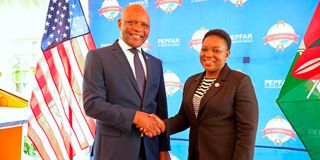Sh2.6bn allocated to HIV fight in budget proposals

US Global Aids Coordinator and Special Representative for Health Diplomacy John Nkengasong with Health CS Susan Nakhumicha during Pepfar Kenya’s 20th anniversary celebrations in Nairobi on January 23, 2023..
The Kenyan government has set aside Sh2.6 billion in the new financial year to fight HIV amid a decline in donor funding.
In the last financial year, the country had allocated Sh2 billion and together with donor funding the total financing was Sh4.6 billion.
Announcing the allocation while celebrating 20 years of the US President’s Emergency Plan for Aids Relief (Pepfar) in Kenya, Health Cabinet Secretary Susan Nakhumicha said the programme’s yearly funding reduction to Kenya has hampered measures to tackle the disease. Pepfar has reduced its disbursement to Kenya by nearly three-quarters in four years.
This year, the programme has allocated $370 million to support the Kenyan government’s response to HIV/Aids.
Out of all finance sources, Pepfar is the primary funder of Kenya’s HIV response.
Over the last year, the country has been struggling with frequent stockouts of drugs and other commodities, including reagents for HIV testing.
Kenya’s health system has a concentrated donor landscape, with four – United States, Global Fund to Fight Aids, Tuberculosis and Malaria, United Kingdom, and Gavi, the Vaccine Alliance – accounting for nearly 90 per cent of all external aid.
“For us to sustain gains and accelerate the progress towards the epidemic control, there is a need to ensure that the Ministry implements a shared and guided structure, long-term planning on Pepfar financing and transition for Kenya beyond 2030 as the country’s economy recovers from Covid-19 pandemic,” Ms Nakhumicha said. The CS said the programme has brought hope to many households affected by the disease.
Over the period of the Pepfar partnership, the country has witnessed a 68 per cent reduction in new HIV infections and 67 per cent in Aids-related deaths.
“This progress was achieved through an increase in the country’s HIV response health workforce, technical assistance and training opportunities and also testing enforcement with over 3,700 antiretroviral sites across the 47 counties,” said Ms Nakhumicha. “We can testify that Pepfar has saved millions of lives not only in Kenya but Africa at large.”
Dr John Nkengasong, the United States Global HIV/Aids Coordinator and Kenya Pepfar Coordinator said the programme will not withdraw, but it’s advocating strong partnerships.
“As incoming Kenya’s Pepfar coordinator, I am looking forward to maintaining a strong partnership towards this struggle,” Dr Nkengasong said. “Each time I look at the journey and the struggle we have had with the epidemic, I think of the impact the programme has created.”
He noted that before the programme, the virus created fear and death and the cost of ARVs was $10,000 dollars, making them unaffordable in Africa. Today, he said, the programme offers hope to individuals and families, having saved 25 million lives and ensured 5.5 million children are born free of HIV/Aids.
“Kenya, for instance, has done so well and almost attained its goals and this will go a long way in achieving our 2030 goals. If we apply ourselves and join forces and commit ourselves to the struggle against HIV/Aids, pulling resources together, we will get there,” Dr Nkengasong said.
Kenya has the fifth largest HIV epidemic in the world with the national prevalence at 4.3 per cent.





